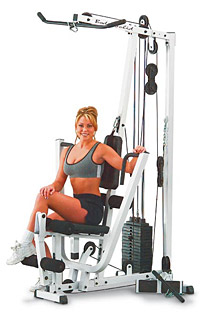 |
 |
 |
 Health & Beauty | August 2005 Health & Beauty | August 2005  
Exercise Guidelines for Women Established
 Stephanie Nano - Associated Press Stephanie Nano - Associated Press


| | Researchers have established how much exercise women should be able to do by age. |
For the first time, researchers have established how much exercise women should be able to do for their age and found that their capacity is slightly lower than men's. It also declines a bit faster than men's as they grow older.

Women whose exercise capacity was less than 85 percent of what it should be were twice as likely to die within eight years, the researchers found.

Until now, the only guidelines available were based on men and it wasn't certain whether they applied to women as well. But as more women are being included in medical research, gender differences in some diseases and other health issues are emerging.

The researchers found that to be true for fitness levels. They used the results of 5,721 exercise stress tests on women over 35 to figure out what should be considered normal for them compared to the established fitness levels for men.

"In general, women's fitness levels seem to be lower regardless of her age than for men," said Dr. Martha Gulati, a Chicago cardiologist who led the study.

While fitness declines with age for everyone, the research showed the difference between men and women becomes more pronounced with age, she said. Women lose about 1 percent of their exercise capacity per year, their study found.

"Given that we live longer, it just emphasizes the importance of fitness for women," said Gulati, who along with a fellow researcher has a patent pending for the fitness guidelines.

Their findings are reported in Thursday's New England Journal of Medicine.

Treadmill stress tests are routinely used to diagnose heart disease, often after someone complains of symptoms such as chest pains or shortness of breath. The heart's activity is monitored while the person walks on the treadmill. The tests cost about $900 at Northwestern Memorial Hospital where Gulati works.

The 5,721 Chicago area women who took the treadmill test in 1992, however, didn't have any symptoms or history of heart problems. They were given a standard stress test with the speed and incline of the treadmill increased every three minutes until they became tired or had other problems.

Their exercise capacity was estimated in metabolic equivalents (METs), based on the speed and grade of the treadmill. One MET is the amount of energy or oxygen used to sit quietly for a minute. Moderate walking burns 3 to 6 METs per minute; running consumes more than 6 METs.

Using data from the volunteers, the researchers came up with a formula to determine the normal fitness level for women. A 50-year-old woman, for example, should be able to reach 8.2 METs. For a 50-year-old man, the predicted exercise capacity is 9.2 METs, based on a different equation.

Although stress tests are relatively inexpensive, Gulati said it isn't necessary to have one to find out what MET level you are achieving. Exercise machines at health clubs do the calculation automatically.

"All of them spit out how many METs you're doing depending on how hard you're working," she said. "A lot of people don't know what it means."

Dr. Gerald Fletcher, a cardiologist at the Mayo Clinic in Jacksonville, Fla., and a spokesman for the American Heart Association, said the guidelines for women will help doctors encourage patients with poor fitness levels to get more exercise to reach their expected MET level.

"Overall, I think this is a very good guideline to be done carefully in people who are not at high risk," he said.

Gulati and her colleagues also tested their fitness equation to see how well it predicted survival during the eight years the volunteers were followed and in another group of 4,471 women with heart-disease symptoms who were followed for five years.

In both groups, women who did under 85 percent of their MET level had twice the risk of death compared to those who did more than 85 percent.

In an accompanying editorial, Drs. William E. Kraus and Pamela S. Douglas suggest that doctors should ask their patients about their exercise habits during each office visit and pay more attention to the fitness levels of those who have stress tests.

"We hope that this report will provide a stimulus to reintroduce fitness assessments into the routine clinical environment for both women and men," they wrote.

On the Net:

New England Journal: http://www.nejm.org | 
 | |
 |



